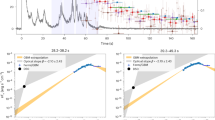Abstract
The discovery of fading but relatively long-lived X-ray emission1 accompanying γ-ray bursts has revolutionized the study of these objects. This ‘afterglow’ is most easily explained by models2,3,4 similar to those describing supernovae, but with relativistic ejecta. And as with supernovae, afterglow measurements should in principle provide important constraints on burst properties, permitting, for example, estimates of the amount of energy released, the geometry of the emitting surface and the density of the ambient medium. Here we report infrared observations of the fading optical transient5 associated with the burst of 14 December 1997 (GRB971214; ref. 6). We detect a ‘break’ in the broad-band spectrum, as predicted by afterglow models, which constrains the total energy in the burst to be >1051 erg. Combining the fluence of optical afterglow with the redshift (z = 3.42; ref. 7), we estimate that the energy released in the afterglow alone was 2× 1051 erg. Estimates of afterglow energetics are less likely to be subject to geometric effects—such as beaming—that render uncertain estimates of the total burst energy, but it nevertheless appears from our measurements that γ-ray bursts may be much more energetic than the 1051 erg usually assumed.
This is a preview of subscription content, access via your institution
Access options
Subscribe to this journal
Receive 51 print issues and online access
$199.00 per year
only $3.90 per issue
Buy this article
- Purchase on Springer Link
- Instant access to full article PDF
Prices may be subject to local taxes which are calculated during checkout


Similar content being viewed by others
References
Costa, E.et al. Discovery of an X-ray afterglow associated with the γ-ray burst of 28 February 1997. Nature 387, 783–785 (1997).
Mészáros, P. & Rees, M. J. Optical and long-wavelength afterglow from gamma-ray bursts. Astrophys. J. 476, 232–237 (1997).
Vietri, M. The afterglow of gamma-ray bursts: the cases of GRB 970228 and GRB 970508. Astrophys. J. 488, 232–237 (1997).
Waxman, E. Gamma-ray-burst afterglow: supporting the cosmological fireball model, constraining parameters, and making prediction. Astrophys. J. 485, L5–L8 (1997).
Halpern, J., Thorstensen, J., Helfand, D. & Costa, E. IAU Circ. No. 6788(1997).
Heise, J.et al. IAU Circ. No. 6787(1997).
Kulkarni, S. R.et al. Identification of a host galaxy at redshift z = 3.42 for the γ-ray burst of 14 December 1997. Nature 393, 35–39 (1998).
Antonelli, L. A.et al. IAU Circ. No. 6792(1997).
Matthews, K. & Soifer, B. T. in Infrared Astronomy with Arrays(ed. McLean, I.) 239–246 (Kluwer, Dordrecht, (1994).
Halpern, J. P., Thorstensen, J. R., Helfand, D. J. & Costa, E. Optical afterglow of the γ-ray burst of 14 December 1997. Nature 393, 41–43 (1998).
Steidel, C. C., Giavalisco, M., Pettini, M., Dickinson, M. & Adelberger, K. Spectroscopic confirmation of a population of normal star-forming galaxies at redshifts z > 3. Astrophys. J. 462, L17–L21 (1996).
Wijers, R. A. M. J., Rees, M. J. & Mèszàros, P. Shocked by GRB 970228: the afterglow of a cosmological fireball. Mon. Not. R. Astron Soc. 288, L51–L56 (1997).
Sokolov, V. V.et al. BVRCIC photometry of GRB 970508 optical remnant: May–August, 1997. Astron. Astrophys.(in the press); also preprint http://xxx.lanl.gov, astro-ph/9802341(1998).
Pedersen, H.et al. Evidence for diverse optical emission from gamma-ray burst sources. Astrophys. J. 496, 311–315 (1998).
Galama, T. J.et al. Optical follow-up of GRB 970508. Astrophys. J.(in the press); also preprint http://xxx.lanl.gov, astro-ph/9802160(1998).
Waxman, E. Gamma-ray burst afterglow: confirming the cosmological fireball model. Astrophys. J. 489, L33–L35 (1997).
Waxman, E., Kulkarni, S. R. & Frail, D. A. Implications of the radio afterglow from the gamma-ray burst of May 8, 1997. Astrophys. J. 497, 288–293 (1998).
Sari, R., Piran, T. & Narayan, R. Spectra and light curves of gamma-ray burst afterglows. Astrophys. J.(in the press).
Diercks, A.et al. IAU Circ. No. 6791(1997).
Tanvir, N., Wyse, R., Gilmore, G. & Corson, C. IAU Circ. No. 6796(1997).
Reichart, D. E. The host galaxy of GRB 971214. Astrophys. J.(submitted); preprint http://xxx.lanl.gov, astro-ph/9801139(1998).
Frail, D. A., Kulkarni, S. R., Nicastro, L., Feroci, M. & Taylor, G. B. The radio afterglow from the γ-ray burst of 8 May 1997. Nature 389, 261–263 (1997).
Kippen, R. M.et al. IAU Circ. No. 6789(1997).
Narayan, R., Paczynski, B. & Piran, T. Gamma-ray bursts as the death throes of massive binary stars. Astrophys. J. 395, L83–L86 (1992).
Rees, M. J. & Mészáros, P. Refreshed shocks and afterglow longevity in gamma-ray bursts. Astrophys. J. 496, L1–L4 (1998).
Henden, A. A., Luginbuhl, C. B. & Vrba, F. J. GCN Note No. 0.16(1997); http://gcn.gsfc.nasa.gov/gcn/gcn3.
Fukugita, M., Shimasaku, K. & Ichikawa, T. Galaxy colors in various photometric band systems. Publ. Astron. Soc. Pacif. 107, 945–958 (1995).
Bessell, M. S. in Stellar Photometry—Current Techniques and Future Developments(eds Butler, C. J. & Elliot, I.) 22–39 (IAU Colloq. 136, Cambridge Univ. Press, (1992).
Paczynski, B. Are gamma-ray bursts in star-forming regions? Astrophys. J. 494, L45–L48 (1998).
Acknowledgements
The W. M. Keck Observatory is operated by the California Association for Research in Astronomy, a scientific partnership among California Institute of Technology, the University of California and NASA. It was made possible by financial support from the W. M. Keck Foundation. The VLA is a facility of the NSF operated under cooperative agreement by associated Universities, Inc. We thank W. Sargent, Director of Palomar Observatory, F. Chaffee, Director of the Keck Observatory and our colleagues for their continued support of our GRB program. S.R.K.'s research is supported by the NSF and NASA. S.G.D. acknowledges partial support from the Bressler Foundation. A.N.R. thanks the International Astronomical Union for a travel grant.
Author information
Authors and Affiliations
Corresponding author
Rights and permissions
About this article
Cite this article
Ramaprakash, A., Kulkarni, S., Frail, D. et al. The energetic afterglow of the γ-ray burst of 14 December 1997. Nature 393, 43–46 (1998). https://doi.org/10.1038/29941
Received:
Accepted:
Issue Date:
DOI: https://doi.org/10.1038/29941
This article is cited by
Comments
By submitting a comment you agree to abide by our Terms and Community Guidelines. If you find something abusive or that does not comply with our terms or guidelines please flag it as inappropriate.



